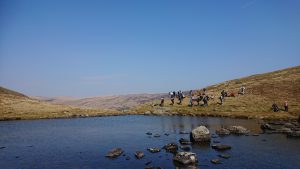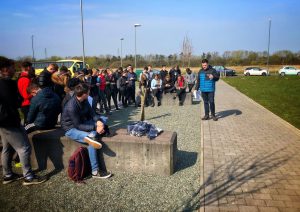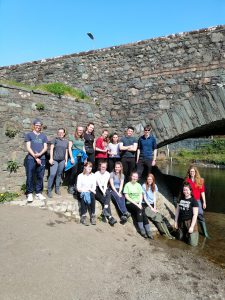
May 23, 2019, by lzzeb
Lake District Fieldtrip 2019
A blog by Hazel Wilson
In mid-April our intrepid first year Geographers and their lecturers were out in the beautiful Lake District learning field techniques for both human and physical geography. This was the Geographical Field Course module which involves a four day residential trip to Blencathra Field Studies Centre, completing small research projects on a variety of topics.
Day one of fieldwork saw the students split into two groups; one visiting nearby Mosedale Valley for the physical geography day, and the other going on a coach tour of West Cumbria for the human geography day. The groups swapped for the second day of fieldwork so everyone got a go at both.
Students on the physical geography day had a short stroll to a viewpoint of Mosedale Valley where they were asked to sketch what they could see. George Swann filled them in on its fascinating geomorphological history and how geographers can interpret features in the landscape. We then continued up to Bowscale Tarn for a spot of lunch. Bowscale tarn and its associated glacial moraine are particularly interesting because the moraine is so unusually large. As good Geographers the students were keen to find out why so we split into small groups to survey the whole moraine, before heading back to the field centre to analyse the data and find out which teams were the most accurate surveyors!
During the human geography day students were treated to a coach tour of Britain’s Energy Coast stopping off at several key sites. We started in Workington, where students learnt about the coast’s complex industrial history, and the region’s varying economic importance over time. Further down the coast at Whitehaven we discovered how the town’s maritime histories and geographies are actively put to work to regenerate the area. Here, we broke for lunch, with many students in search of some well earnt fish and chips! After lunch, we visited the Sellafield Plant, a large nuclear energy facility. Students reviewed the arguments for and against nuclear energy, and reflected upon the economic significance of the nuclear site locally and nationally. Lastly, we visited the small coastal village of Seascale, rounding off the day with a reflection on the region. For those with a sweet tooth, a visit to the local ice cream parlour was a must, before returning to the field centre to write up their group projects.
On the third day of fieldwork, students were given a choice of projects. Options included investigating economic change and rejuvenation in Workington, measuring plastic pollution in the River Derwent, exploring the visual geographies of Keswick using Instagram, using food to understand place and identity, identifying where best to site a wind farm, creating a World Heritage site visitor display, and looking into flooding risks under future climate change.
After a busy few days tired students (and staff!) were ready to head home, all the wiser for having learnt so much about Lake District fieldwork! It’s been a successful trip, helping to build a good basis in both human and physical geography techniques for research, which will be very useful for the next few years of undergraduate study.
No comments yet, fill out a comment to be the first




Leave a Reply